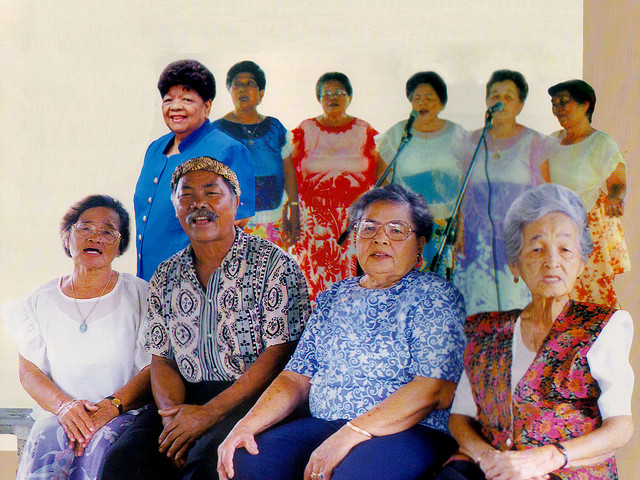Kantan Chamorita
Table of Contents
Share This
Impromptu verse making

Kantan Chamorita is the contemporary name given to traditional call-and-response, impromptu verse-making. Practitioners refer to the genre as ayotte’, meaning to throw (verses) back and forth. Early missionaries of the 17th century observed the practice of poetic debate that took place between clans who gathered to compete to see who could sing the most couplets. A visitor to Guam in 1683, Padre S.J. Garcia, described the singing as such:
They admire poetry and believe poets to be men who perform wonders… They sing in verse their histories and ancient things with measured time and harmony of three voices: soprano, contraltos, and falsettos, with the occasional tenor assistance of one of the principales who attend these feasts.
Anthropologist Laura Thompson wrote of the call-and-response, impromptu verse-making form she observed in 1938, which she said was called Chamorita. Elders who know the song form today call it “Chamorita singing”, or in CHamoru, Kantan Chamorita.
The verses are comprised of four lines, with the second and fourth lines rhyming. The fourth “punch line” challenges opponents to incorporate this line into the response. The first two lines are carried by a tenor, falsetto, or soprano voice while the last two lines are sung in chorus, or an individual may sing to another in falsetto. Kim Bailey, an ethnomusicologist who studied the Chamorita in the 1980s in Guam and Rota, gave a technical description of the art form. She described Chamoritas as:
…ancient folk songs, arranged in quatrains of two octosyllabic couplets, which, according to some writers, are composed on a single melody, the variations depending on the individual style of performance. The distinctive features are spontaneous improvisation and a dialogue performance between two or more people, depending on the occasion and function.
An important feature of Kantan Chamorita is the poetic artistry and layers of meaning contained in the verses. The Chamorita, when used as a socially acceptable courting or flirtation device, might present words of apparent innocence on the surface with a special hidden meaning for the intended receiver. Neighbors or relatives might use the song form to resolve misunderstandings through lyrics with metaphors which address the grievance in non-confrontational ways.
The most popular usage of the Kantan Chamorita has always been to tease and ridicule one another without causing shame or embarrassment to anyone. Sample texts with translations are provided by Laura Souder to point out common themes as well as to show how metaphors changed with the experiences of the people:
Courting
| CHamoru | English |
|---|---|
| Ti gumadi yu’ put ti’ao | I’m not fishing for small fish |
| Na gumadi yu’ put hagu | I’m casting my net for you |
| An’ chumefla yu’ tres biahi | When I whistle three times |
| Yute’ gadi ya’un falagu. | Throw your net and run. |
Sexual mockery
| Antes gi annai tiempo-mu | A while ago when it was your time |
| Kalan makina hao ni’ bibu | You were like a fast machine |
| Annai esta ti tiempo-mu | Now that time is no longer yours |
| Kalan puyitos manok hao ni’ figo. | You are like a shivering chick. |
Joining the military
| Basta nana de tumanges | Stop crying, my mother |
| Saosao todu i lago’-mu | Wipe away your tears |
| Sa’ ti u apmam na tiempo | Because it won’t be long |
| Siempre u fatto i lahi-mu | Before your son will return. |
Kantan Chamorita audio samples
Kantan Chamorita, Inalåhan Shores Thatching Party
Kantan Chamorita, Guam’s History in Song
Video
For further reading
Bailey, CR Kim. “Chamorrita Songs: A Surviving Legacy of the Mexican Verso?” Paper presented at the 26th Annual Meeting of the Society for Ethnomusicology, Honolulu, HI, October 1981.
García, Francisco. The Life and Martyrdom of Diego Luis de San Vitores, S.J. Translated by Margaret M. Higgins, Felicia Plaza, and Juan MH Ledesma. Edited by James A. McDonough. MARC Monograph Series 3. Mangilao: Micronesian Area Research Center, University of Guam, 2004.
Lévesque, Rodrigue. History of Micronesia: A Collection of Source Documents. Vols. 1-6. Québec: Lévesque Publications, 1992-1995.
Peck, William M. “The Songs of the Chamorrita.” Islander (Pacific Daily News), 6 December 1981.
Souder, Laura MT. “Kantan Chamorrita: Traditional Chamorro Poetry, Past and Future.” Pacific Journal of International Writing 5, no. 1 (1993): 189-192.
Thompson, Laura M. Guam and Its People. With a Village Journal by Jesus C. Barcinas. 3rd ed. New Jersey: Princeton University Press, 1947.
